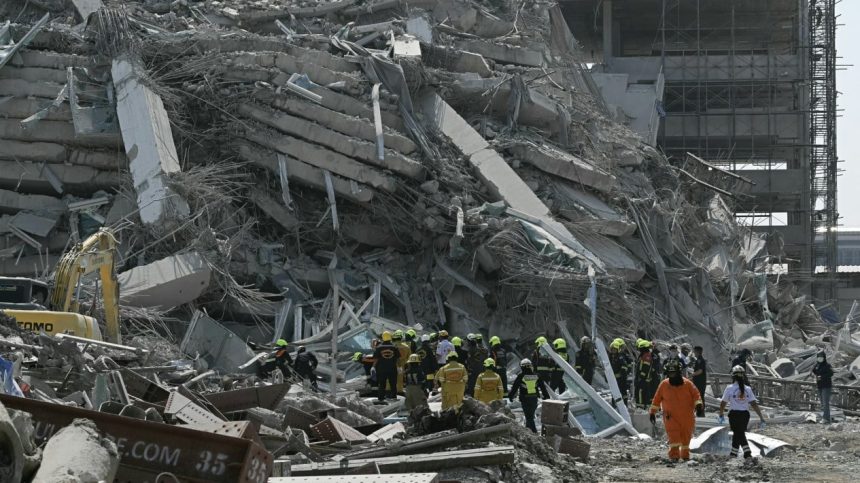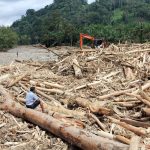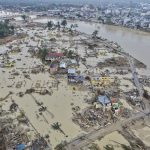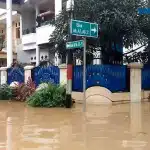Liga Asuransi – Reader friends, how are you? We are deeply saddened by the 7.7 magnitude earthquake that struck Myanmar and Thailand on March 28 2025. This disaster resulted in loss of life and significant infrastructure damage in both countries. Hopefully the affected victims will be given strength and fortitude to face this ordeal. This incident reminds us of the importance of preparedness and risk management in facing natural disasters. Through this discussion, we hope to increase awareness of the importance of risk mitigation and insurance protection to minimize the impact of similar disasters in the future.
On March 28 2025, a powerful earthquake measuring 7.7 magnitude rocked the Southeast Asia region, with the epicenter located near Mandalay, Myanmar. The strong shaking caused severe damage in Myanmar and Thailand, including the collapse of buildings and important infrastructure. In Bangkok, Thailand, a 33-story skyscraper under construction collapsed, killing at least six people and injuring 22 others. Apart from that, this earthquake was also felt in Yunnan and Sichuan provinces in China, causing damage and injuries.
This incident highlights how important it is to understand the impact of earthquakes in an insurance context. Earthquake insurance provides financial protection against loss or damage to property caused by earthquakes, volcanic eruptions, fires, explosions and tsunamis. By having this insurance, individuals and businesses can mitigate financial risks arising from natural disasters, so that the recovery process can run more smoothly without significantly burdening their financial condition. Without insurance, the costs of repairing and replacing damaged assets can become a heavy burden that hinders post-disaster economic recovery. Therefore, having earthquake insurance is a proactive step in risk management, especially for those who live in earthquake-prone areas.
In Thailand, an earthquake caused the collapse of a 33-story building under construction in Bangkok, killing at least six people and injuring 22 others. The shaking was felt across the country, causing panic and mass evacuations.
Aftershocks of significant magnitude occurred after the main quake, worsening damage and hampering rescue efforts. The impact of the earthquake was also felt in neighboring countries such as China, Bangladesh and India, with reports of damage and injuries in various regions.
This incident highlights the importance of disaster preparedness and mitigation in earthquake-prone areas.
Powerful Earthquake Rocks Myanmar and Thailand
The 7.7 magnitude earthquake that hit Myanmar and Thailand on March 28 2025 has caused significant impacts in various aspects, including loss of life, damage to infrastructure and the economy.
Fatalities and Injuries
As of this writing, in Myanmar, more than 144 people were reported to have died and around 730 others were injured as a result of the earthquake. In Thailand, particularly in Bangkok, at least 10 people were killed and 16 others injured, with 101 people reported missing after the collapse of a skyscraper under construction.
Infrastructure Damage
This earthquake caused severe damage to infrastructure in both countries. In Myanmar, the city of Mandalay suffered significant destruction, with many buildings and public facilities heavily damaged. Five spans of the bridge connecting Sagaing City and Mandalay were seriously damaged, hampering mobility and rescue efforts. In Thailand, apart from the collapse of a 34-story building in the Chatuchak district, Bangkok, which killed three people and left 81 others missing, the earthquake also damaged public facilities such as hospitals, schools and places of worship. Electricity and water services in several affected areas were completely paralyzed, while communication networks were also disrupted.
Economic Impact
Damage to property and infrastructure due to this earthquake is estimated to cause enormous economic losses. Disconnected electricity and water services, as well as disrupted communications networks, further worsened the economic situation. Disruption to business and trade activities was also significant, with many companies forced to temporarily suspend operations. The Thai government designated Bangkok as an emergency zone, reflecting the severity of the situation and its impact on the local economy.
Overall, these earthquakes highlight the importance of disaster preparedness and mitigation in earthquake-prone areas, as well as the need for adequate insurance to protect individuals and businesses from financial losses due to natural disasters.
Actions of the Governments of Myanmar and Thailand
The Myanmar government, through the ruling military junta, immediately declared emergency status in six badly affected regions, including Sagaing, Mandalay, Bago, Magway, Shan State and Naypyidaw. Senior General Min Aung Hlaing, the junta leader, visited a hospital in Naypyidaw to inspect the treatment of the injured and formally request international assistance to deal with the impact of the disaster.
In Thailand, Prime Minister Paetongtarn Shinawatra cut short his visit to Phuket to return to Bangkok and chair an emergency meeting on the disaster. He also visited the site of the building collapse in Chatuchak district. The Governor of Bangkok, Chadchart Sittipunt, designated the city as a level 2 disaster area and opened public parks such as Lumphini, Benchasiri, Benjakitti and Chatuchak as temporary shelters for affected residents.
Efforts to Evacuate and Rescue Victims
Rescue teams from various regions in Myanmar, including the Ayeyarwady Region and Yangon, were deployed to Naypyidaw to assist with search and rescue operations. However, reports from Mandalay indicated that rescue operations were slow due to a shortage of personnel and equipment, with many collapsed buildings not yet fully explored.
In Thailand, authorities focused on evacuating residents from damaged buildings and searching for victims in affected locations, especially in Bangkok. Emergency services worked around the clock to evacuate trapped victims and provide medical treatment to the injured.
International Assistance
The international community responded quickly to Myanmar’s request for assistance. The United Nations (UN) deployed teams on the ground to assist with recovery efforts and provided initial funding of $5 million for emergency relief. Neighboring countries, including Malaysia and Indonesia, expressed their readiness to provide support. Malaysian Prime Minister, Anwar Ibrahim, expressed his condolences and concern over the disaster. Meanwhile, the President of Indonesia, Prabowo Subianto, stated that Indonesia is ready to provide all necessary support for recovery efforts in the affected areas.
Humanitarian aid coordination involves various international and regional organizations. The ASEAN Humanitarian Assistance Coordination Center (AHA Centre) participated in distributing aid and ensuring effective distribution to the victims.
This rapid response from governments and the international community demonstrates global solidarity in the face of natural disasters and the importance of cross-border cooperation for effective recovery.
The Role of Insurance in Mitigating Earthquake Risk
Earthquakes are one of the natural disasters that can cause significant losses to individuals and businesses. In facing this risk, earthquake insurance becomes an important instrument in mitigating financial risks.
The Importance of Earthquake Insurance
Earthquake insurance provides financial protection against loss or damage to property caused by earthquakes, volcanic eruptions, fires, explosions and tsunamis. By having this insurance, individuals and businesses can obtain compensation for property damage, thereby facilitating the post-disaster recovery process without significantly burdening their financial condition. For example, earthquake insurance can cover damage to residential buildings, building contents, machinery and inventory located within the insured property.
Insurance Penetration Rate in Myanmar and Thailand
In Myanmar and Thailand, earthquake insurance penetration levels are still relatively low. Many properties are not yet insured against earthquake risks, thereby increasing people’s financial vulnerability when a disaster occurs. One of the main challenges in increasing public awareness and participation in earthquake insurance is a lack of understanding of the benefits of insurance and the perception that insurance premiums are an additional burden. Apart from that, economic factors and limited access to insurance products are also obstacles in increasing earthquake insurance penetration in the two countries.
To overcome this challenge, intensive educational efforts are needed regarding the importance of earthquake insurance and its benefits in providing financial protection. The government and insurance companies can work together to provide insurance products that are affordable and easily accessible to the wider community. Thus, it is hoped that more individuals and businesses will realize the importance of having earthquake insurance as a proactive step in mitigating the risk of natural disasters.
Insurance Claim Process
Filing a post-earthquake insurance claim requires a good understanding of the procedures to be followed as well as the role of related parties, such as insurance brokers, in facilitating the process.
After suffering a loss due to an earthquake, the policy holder should follow the following steps:
- Reporting Losses: Immediately inform the insurance company of the incident, usually within 3 calendar days from the date of the incident. Reports can be made via the hotline or nearest branch office.
- Complete the Claim Form: Complete the claim form provided by the insurance company to document the details of the loss experienced.
- Provide Supporting Documentation: Include documents such as:
- Copy of insurance policy and proof of premium payment.
- A certificate from the police or related agency regarding the earthquake incident.
- Photos or videos showing property damage.
- Inventory list of damaged goods along with the estimated value of the loss.
- Personal identity documents such as KTP or NPWP.
- Field Inspection: The insurance company will send a team to assess the damage and verify the claim submitted.
- Claim Settlement: After verification, the insurance company will determine the amount of compensation in accordance with the policy provisions and make payment within the specified time period.
Barriers to the Claims Process
Policyholders may face several obstacles, such as:
- Delay in Reporting: Missing the established reporting deadline may result in claim denial.
- Incomplete Documentation: Lack of supporting documentation can slow down the claim process or lead to denial.
- Unclearness in the Policy: Insufficient understanding of the coverage and exclusions in the policy can lead to expectations that do not match the reality of compensation.
The Role of Insurance Brokers in Assisting the Claims Process
Insurance brokers play an important role in:
- Consultation and Education: Providing policyholders with an understanding of their rights and obligations as well as the claim procedures that must be followed.
- Claims Process Assistance: Assists in the collection and preparation of required documents, as well as ensuring that claims are submitted according to procedures.
- Negotiations with Insurance Companies: Represent the interests of policyholders in communicating and negotiating with insurance companies to ensure fair claim settlement and in accordance with policy provisions.
By understanding the claims process and utilizing the assistance of an insurance broker, policyholders can increase their chances of obtaining appropriate compensation and speed up post-disaster recovery.
The earthquake that struck Myanmar and Thailand on March 28 2025 highlighted the importance of financial preparedness in dealing with natural disasters. One crucial step is to increase public awareness of the importance of disaster insurance and develop insurance products that suit the needs of earthquake-prone areas.
Increasing Awareness of Disaster Insurance
To increase public understanding of the importance of earthquake insurance, a comprehensive education strategy is needed. The government can play an active role by integrating education about disaster risk management and insurance benefits into the school curriculum and holding informative public campaigns. The private sector, especially insurance companies, can contribute through outreach programs that explain the benefits and mechanisms of earthquake insurance, as well as providing simulations or case studies to provide a real picture to the public. Collaboration between the government and the private sector in the form of public-private partnerships (PPP) can also strengthen these efforts, where the government provides public facilities and increases public awareness, while the private sector provides operational resources, finance and experts.
Development of Appropriate Insurance Products
Innovation in insurance products is very important to meet the needs of people in earthquake-prone areas. Insurance companies need to develop flexible policies with coverage that can be adjusted based on regional risk levels. Premium adjustments based on risk location, building construction class, and other factors in accordance with Financial Services Authority (OJK) regulations can increase the affordability and relevance of insurance products for the public. In addition, implementing a mandatory insurance scheme for property in earthquake-prone areas, as is done in several countries, could be considered to increase public participation in insurance protection.
With a combination of effective education and the development of appropriate insurance products, it is hoped that people in earthquake-prone areas will be better prepared financially to face potential disasters in the future.
The earthquake that hit Myanmar and Thailand on March 28 2025 emphasized the importance of financial preparedness in facing natural disasters. Earthquake insurance plays a vital role in providing protection against material losses due to earthquakes. In this context, the role of insurance brokers becomes crucial in helping individuals and businesses understand and manage these risks.
Role of Insurance Broker
Insurance broker acts as an independent intermediary representing the interests of the insured in interacting with insurance companies. They help in assessing the type of risk faced, developing appropriate risk management strategies, as well as selecting the right insurance product based on the client’s risk profile and specific needs. In addition, insurance brokers have a responsibility to ensure that each risk is properly positioned and adequately protected in the insurance market, as well as providing accurate and comprehensive information to insurers, both in risk placement and claims handling.
Conclusion
In the post-disaster claims process, insurance brokers play an active role in guiding policyholders through complex claims procedures, helping complete required documents, and negotiating with insurance companies to ensure fair claim settlement and in accordance with policy provisions. Thus, insurance brokers not only facilitate the claims process, but also ensure that the rights and obligations of the insured are properly understood and fulfilled.
Overall, insurance brokers play an important role in increasing awareness of the importance of disaster insurance, assisting in selecting appropriate insurance products, as well as supporting policyholders in the claims process, thereby strengthening society’s financial resilience against the risk of earthquakes and other natural disasters.
Looking for insurance products? Don’t waste your time and contact us now
HOTLINE L&G 24 JAM: 0811-8507-773 (CALL – WHATSAPP – SMS)
Website: lngrisk.co.id
Email: oktoyar.meli@lngrisk.co.id
—















